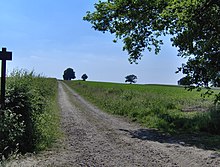Ash corridor

An ash corridor is a historical corridor shape that is particularly widespread in northwest Germany and the neighboring Netherlands . Esch (also Ösch , from ahd. Ezzisc 'seed field') means: unchecked seed field , arable land . In modern parlance, ash is the higher-lying arable land near the farm.
Landscapes with ash corridors usually have special agro-ecological locations that did not allow area-wide arable farming. Only the esch itself was suitable for growing grain; the rest of the area was usually moist with groundwater and could therefore only be used extensively . Typical of Esch corridors was well into the 19th century single span economy with Plagge fertilization , which nutrients from forest or heath of Agriculture were transferred. Marginal yield areas were used as grazing land. The arable land was usually surrounded by hedges in order to protect the valuable areas from browsing and being represented by cattle.
In Low German, in north-western Germany and the eastern Netherlands, Esch ( Dutch : es , more western: eng or enk ; semasiologically related to the term Anger ) is still the name for an old, often subdivided into long strips of mixed land with mostly loose group settlement , the drubbing . The ash was mostly fertilized with heather plague so that a plagge ash floor was created.
The German legal dictionary defines Esch as “the entire seed field of the village marking, as well as the individual gain ”. This term was used as ezsche as early as 1249 in a Westphalian document.
See also
- Eschdorf , disambiguation
- Podzol
- Plaggenesch